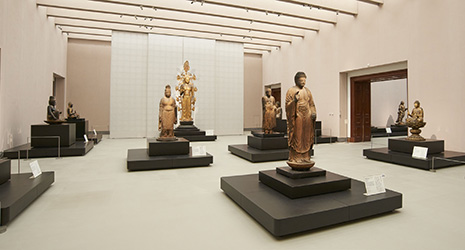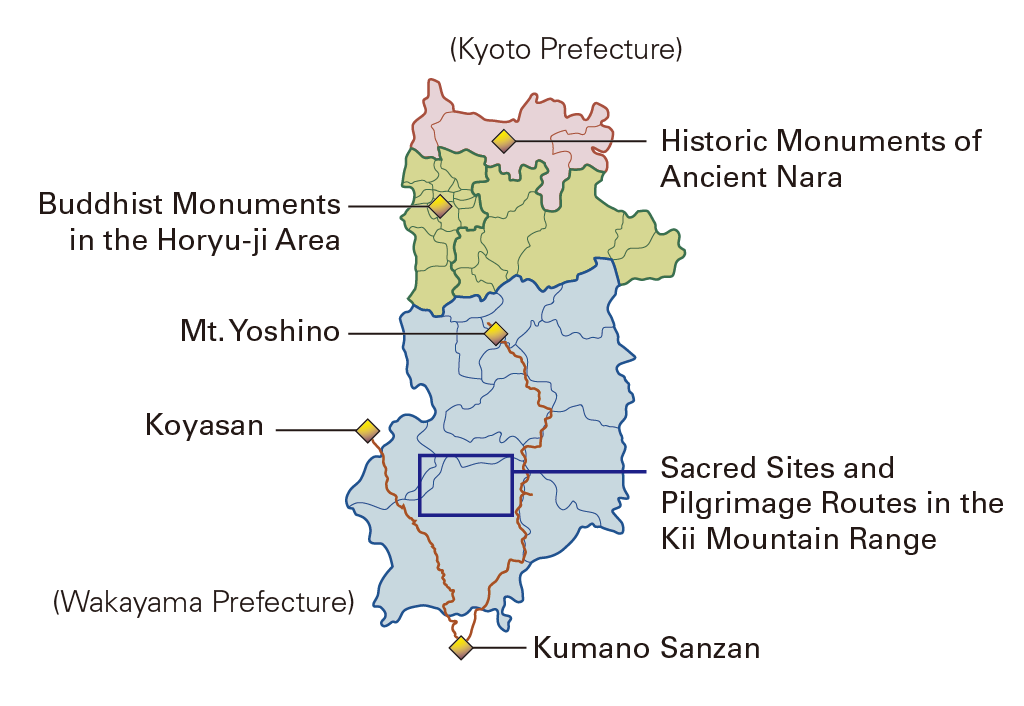INDEX
- English
- 日本語

Buddhist sculptures on display at the Nara Buddhist Sculpture Hall - English
- 日本語

Sacred deer in Nara Park
December 2020
Nara: A Treasury of Ancient Japanese Culture

Nara is a special place where visitors can experience the ancient history and culture of Japan, surrounded by World Heritage sites and museums showcasing works of art and historical resources, great numbers of which are National Treasures and Important Cultural Properties.

Nara Prefecture is situated at the center of the Kii Peninsula in Honshu, the largest of Japan’s four main islands, and bordering Kyoto to the north. There are more World Heritage sites in Nara than in any other prefecture. These are “The Historic Monuments of Ancient Nara”; “Buddhist Monuments in the Horyu-ji Area”; and “Sacred Sites and Pilgrimage Routes in the Kii Mountain Range,” the last of which spans the prefectures of Nara, Mie (to the east) and Wakayama (to the west). Nara is home to many more cultural assets besides these sites, and many of these have been designated National Treasures and Important Cultural Properties. Six museums of art and history have been certified by the Agency for Cultural Affairs of the Japanese Government. These are centers for the promotion of cultural tourism, and their official certification makes them more widely known to visitors eager to immerse themselves in the rich cultural legacies of Nara.
When Buddhism arrived in Japan from the Asian continent in the sixth century, the flowering of Japanese culture was centered in Nara.
Horyu-ji Temple was founded at this time by Prince Shotoku (574–622), a devout student and patron of Buddhism. The temple has international significance as the oldest extant wooden building anywhere in the world.
“Asuka-Fujiwara: Archaeological sites of Japan’s Ancient Capitals and Related Properties,” as the site is listed on UNESCO’s World Heritage Tentative List, is comprised of a cluster of twenty properties, principally the archaeological remains of palaces, gardens, temples and burial mounds built during the Asuka period (592–710). Among them, the Takamatsuzuka Tomb in Asuka Village is a highlight, famous for its colorful wall paintings, which have been designated as a National Treasure.
The Asuka period came to an end and the Nara Period (710–794) began when the capital of Heijo-kyo was established in the present-day city of Nara. It was a time when Buddhist culture flourished. All of the eight properties included in UNESCO’s “Historic Monuments of Ancient Nara” are within the city of Nara, which is just 30 minutes from neighboring Kyoto by express train on the Kintetsu Line.
Within walking distance of Kintetsu-Nara Station is Nara Park, famous for its large population of sacred deer. Also situated in this area are Todai-ji Temple and its Great Buddha Hall; Kasuga Taisha Shrine and its sacred precincts of the Mt. Kasuga Primeval Forest; Kofuku-ji Temple; and the Nara National Museum, one of the aforementioned institutions certified as a base for cultural tourism.
Kawashima Keiichi of the Nara National Museum’s General Affairs Division says, “Originally a part of the Kofuku-ji Temple grounds, Nara Park lies adjacent to the Kasuga Taisha Shrine. According to legend, the shrine originated when the deity Takemikazuchi no Mikoto rode into Nara on a deer from the Kashima Shrine in Ibaraki Prefecture. That is why to this day the deer in Nara Park are thought of as sacred animals or emissaries of the gods, and they have been carefully protected for centuries.”
Explaining the appeal of the area, Kawashima continues, “I believe visitors are attracted by the natural assets that enable them to feel the atmosphere of the ancient capital during the Asuka-Nara period.”
The Nara Buddhist Sculpture Hall at the Nara National Museum exhibits a collection of close to 100 Buddhist sculptures at all times. These masterworks were largely produced from the Asuka period to the Kamakura period (1185–1333).
Nonaka Hiromi of the Nara Prefectural Government’s Cultural Resource Utilization Division says, “Buddhist sculptures can be identified by their iconography and style, and on the basis of this analysis, they can be dated. This allows us to follow the transitions of history. Visitors are able to see quite a few ancient Buddhist sculptures that were made even before the Heian period (794–1185), which are not usually exhibited elsewhere in Japan. I feel that the Buddhist sculptures in Nara have a distinct appeal in terms of their artistic style and form.”
The World Heritage site “Sacred Sites and Pilgrimage Routes in the Kii Mountain Range” is made up of three sacred sites and their connecting pilgrimage routes in Nara, Wakayama and Mie Prefectures. The sites in Nara that are a part of this World Heritage site include Mt. Yoshino and Kimpusen-ji Temple, the core temple of a branch of the Shugendo religion. Mt. Yoshino is a place of training for the Japanese mountain religion of Shugendo, which evolved as a fusion of sacred mountain worship and Buddhism. Mt. Yoshino is also famous for its cherry blossoms.
In addition to protecting and highlighting its historical sites, Nara Prefecture is also promoting the products and many charms of its agricultural sector. In 2016, the NARA Agriculture and Food International College (NAFIC) was established in Sakurai City in central Nara Prefecture, aiming to train professional cooks and workers with a wide variety of specialties to take full advantage of the exquisite produce cultivated in Nara Prefecture. Adjacent to the college is L’auberge de Plaisance Sakurai, a hotel with a French restaurant that provides students with on-the-job training for preparing and serving dishes featuring locally-sourced vegetables and meat.
Nara National Museum’s Kawashima says, “We are committed to continuing to publicize the beauty and allure of culture in Nara Prefecture and leveraging stronger partnerships with various organizations, including local municipal government offices, museums of history and art, and private sector entities.”
Visitors to Nara could never experience its wealth of enriching and enchanting attractions in a single day.


